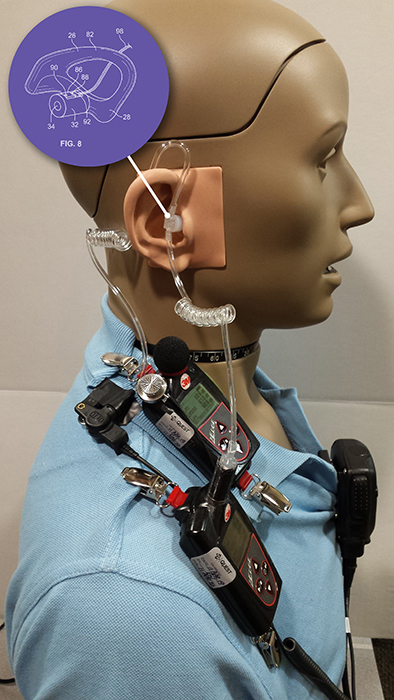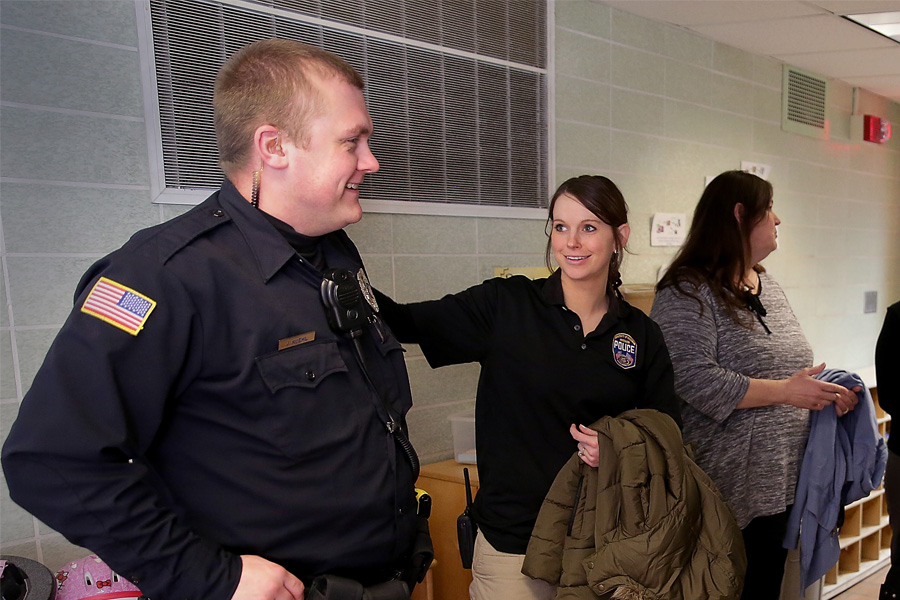UW-Whitewater faculty receive patent for noise-measuring device that can help prevent hearing loss
March 26, 2020
Photos by Craig Schreiner | Written by Kristine Zaballos
Two faculty members at the University of Wisconsin-Whitewater have collaborated with engineers to produce a device that has received a U.S. patent. The device, an in-ear noise dosimeter, allows for noise measurement within the ear canal, which provides a more accurate assessment of noise exposure than current devices.
Included as inventors on the patent are Lynn Gilbertson, associate professor of communication sciences and disorders in the College of Education and Professional Studies, Donna Vosburgh, associate professor of occupational and environmental safety and health in the College of Business and Economics, and Tim Klein, a private industry contract engineer.
The device measures the potential impact of the increasingly common use of in-ear communication devices, or “comm sets,” among workers in industries as widespread as the military, construction, police, EMS and firefighting, and manufacturing and warehousing. Most dosimeters, which measure sound decibels, are placed near a worker’s shoulder; as a result, before this invention there was no available device for testing whether prolonged exposure to the in-ear communication sets could affect hearing health on the job.
Gilbertson and Vosburgh first began collaborating on campus in 2014. As they looked for possible research subjects, Gilbertson mentioned the increasing use of radio communication through earpieces. While some professions were reporting an increase in hearing loss, there was no data to support the devices playing a role. Both Gilbertson and Vosburgh posited that available dosimeters simply couldn’t measure the full impact of the in-ear devices on hearing. So, the two set out to develop and lab- and field-test an in-ear dosimeter.

Colleagues at UW-Platteville who contributed to the development of the prototype include Development Specialist John P. Fick, a new product development engineer, Associate Professor of Mechanical Engineering Anne-Marie A. Lerner, and engineering students John J. Lee and Ethan M. Derner.
“It is wonderful to see this cross-disciplinary effort come together to have an impact on hearing health advocacy,” said Gilbertson. “No one is an expert in everything; to solve complex, real-world problems like this it takes a team with expertise in science, health care, industry, and the humanities.”
Three UW-Whitewater students also participated in the research and testing phase of the prototype development. Gina Sanfelippo and Rachel Moldenhauer, both undergraduate majors in communication sciences and disorders, supported the lab testing of the prototype. Connor Carrington, an occupational safety major, contributed to data collection efforts during field testing of the prototype with UW-Whitewater police officers.
“We agreed to participate in the research from two perspectives,” said UW-Whitewater Police Chief Matt Kiederlen. “We always want to assist students in positive endeavors, and I recognized the potential hearing improvement and protection their research could provide. Understanding the effects that consistent radio usage has on users can only lead to improvements in equipment effectiveness and efficiencies.”

UW-Whitewater police officer Josh Kuehl, left, wears an in-ear communication device.
Lab and field testing confirmed the hypothesis that an in-ear device would lead to a more accurate measurement.
“We measured a difference in sound pressure level of 1 to 10 decibels between traditional dosimeters, which are commonly attached to the wearer’s clothing near the shoulder, and our in-ear device,” said Gilbertson. “That can have a significant implication for hearing health. In field testing, this led to some good conversations about hearing loss prevention.”
In field testing, levels above 85 decibels were detected.
“According to the National Institute for Occupational Safety and Health, once a worker is exposed to noise over 85 decibels, a three-decibel increase in exposure drops a worker’s recommended time working in that noise by half,” said Vosburgh. “A noise exposure increase of 6 decibels will reduce an eight-hour work day to two hours.”
WiSys, the independent, nonprofit supporting organization designated as the official technology transfer office for the UW System comprehensive campuses, sponsored the patent application for the devices. The project also received grant support from a WiSys Technology Advancement Grant (WiTAG) and a WiSys Prototype Development Fund.
In its role supporting the development of the product, WiSys will market the technology to potential manufacturers. Should the device come to market, users of in-ear communication devices such as officers with the UW-Whitewater Police Department will have a more accurate way to measure — and mitigate — their exposure to harmful levels of noise.
“For us the motivation is that these are measurable levels for occupations that have high risk of hearing loss,” said Gilbertson. “We are working on a manuscript to share out with the scientific and professional community,” said Gilbertson. “We will continue to explore how to better measure noise exposure and advocate for hearing health.”
For more information on the device, contact Lynn Gilbertson at gilbertl@uww.edu or 262-472-5203.
